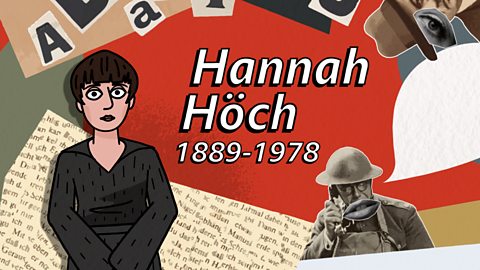Key facts about Eduardo Paolozzi

Eduardo Paolozzi was a Scottish artist. He was born in 1924 near Edinburgh, Scotland and died in 2005.
Many people think of Paolozzi as the person who started an art movement called Pop ArtArt made about popular things and people, such as fashion and celebrities..
He made collageArt made by gluing materials to a surface., sculptureA type of art that is three-dimensional or not flat., and printAn image made by pushing a design onto a surface. from the 1950s through to the 1990s. He is also well known for his mosaicsA mosaic is a picture made by arranging together small pieces of stone, tiles or other materials..

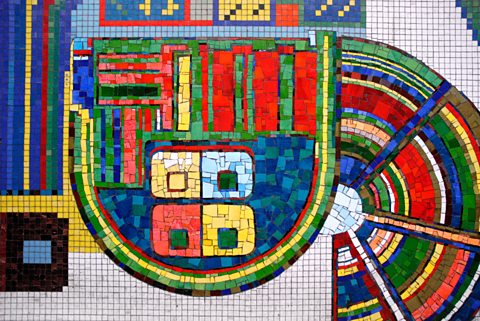
In 1986, Paolozzi completed one of his best-known pieces.
It was a large work of colourful mosaics at Tottenham Court Road Underground station in London.
You can still go and see the mosaics today.
Watch: Who was Eduardo Paolozzi?
Learn more about the life and art of Eduardo Paolozzi
Narrator: Eduardo Paolozzi was born in Leith, in Edinburgh, in 1924 where his parents ran an ice cream shop.
Growing up, he was surrounded by bright colours, products and adverts.
He would cut out pictures from these adverts to make collages.
He studied art and went on to be an art teacher in universities.
Paolozzi was a huge influence on pop art.
He was one of the first to use screen printing for art.
He experimented with other media and didn't just stick to one.
He sometimes sketched an idea then turned it into a mosaic or sculpture.
Some of his sculptures looked like they had been pulled apart then put back together.
His collages, mosaics, sculptures and drawings can still be seen in museums, galleries and even the London Underground.
By experimenting with different types of art, Eduardo Paolozzi has inspired artists and designers everywhere, for decades.
Eduardo Paolozzi's artworks

Image caption, Paolozzi used collage a lot over the years. He used items such as old tickets, parts of his own art, magazine and newspaper scraps. He sometimes included sketches or drawings too and often used collages to help him plan his larger works. The surface behind this piece is squared - also known as mathematical paper. Image: Collage by Eduardo Paolozzi © The Paolozzi Foundation, Licensed by DACS 2023.
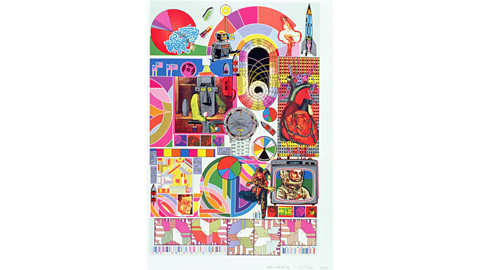
Image caption, In the 1950s Paolozzi became interested in popular culture (music, fashion and other interests liked by lots of people at the same time). He and his friends made art about new technology, music, fashion and issues that came up in the news. Some images appear again and again in his work, such as robots, rockets, famous people and toys. Bash, made in 1971 was his idea of what the future might look like. Image: Bash (print) by Eduardo Paolozzi © The Paolozzi Foundation, Licensed by DACS 2023.
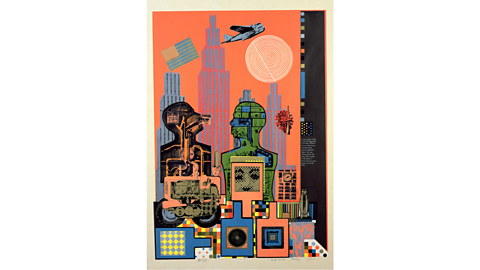
Image caption, This piece was inspired by the author Ludwig Wittgenstein. It is a print rather than a collage, but with a similar style to Paolozzi's collages. The images in it are jumbled and overlapping. They include skyscrapers, circuit boards and types of transport. Image: Wittgenstein in New York by Eduardo Paolozzi © The Paolozzi Foundation, Licensed by DACS 2023
1 of 3
Eduardo Paolozzi's factfile
Activity
Did you know?
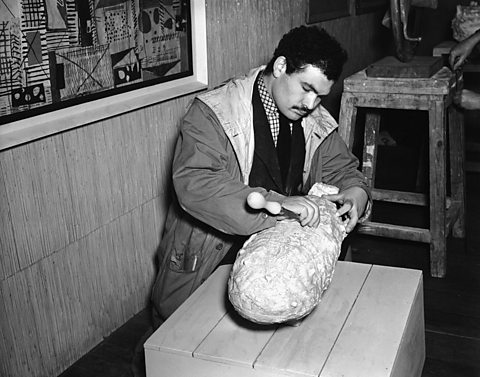
- Eduardo Paolozzi's parents were from the Lazio region in central Italy.
- His parents had an ice cream shop in Leith, near Edinburgh.
- Paolozzi was knightedA knighthood is a title given to a male by the British Monarch for achievements or service to the country. by Queen Elizabeth II in 1989.

Quiz
Play Art Gallery Rescue. gamePlay Art Gallery Rescue
Help Lily and Will rescue the art gallery!

SATs preparation resources. activitySATs preparation resources
Get ready for the SATs papers with videos, activities, quizzes and games to refresh your knowledge and practise your skills.

More on Collage
Find out more by working through a topic
- count3 of 3
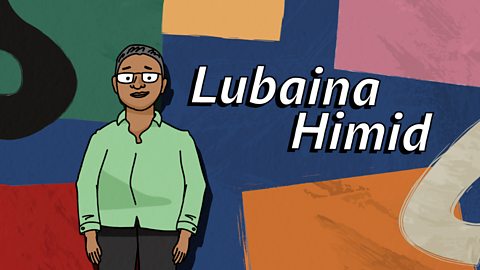
- count1 of 3
